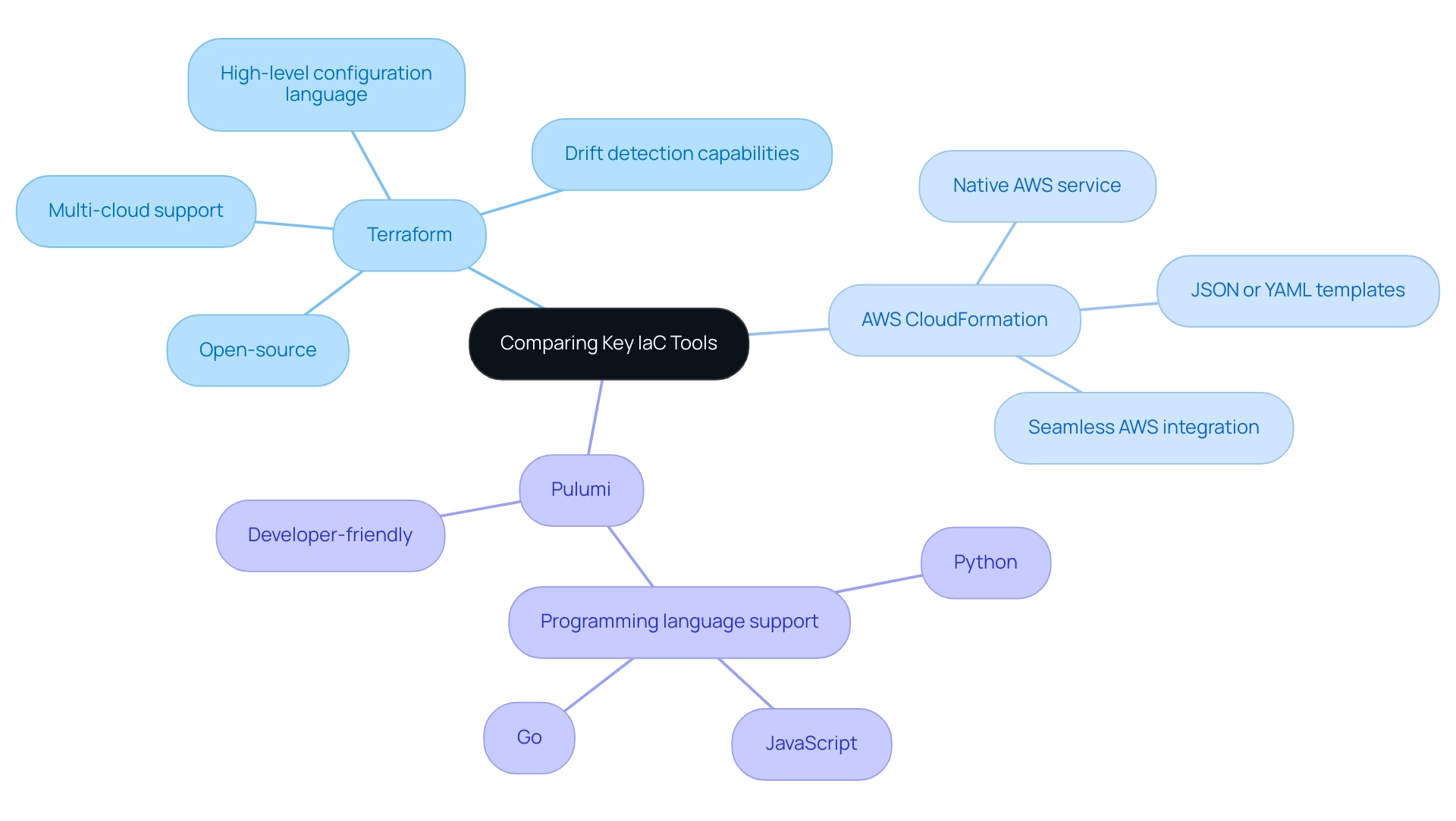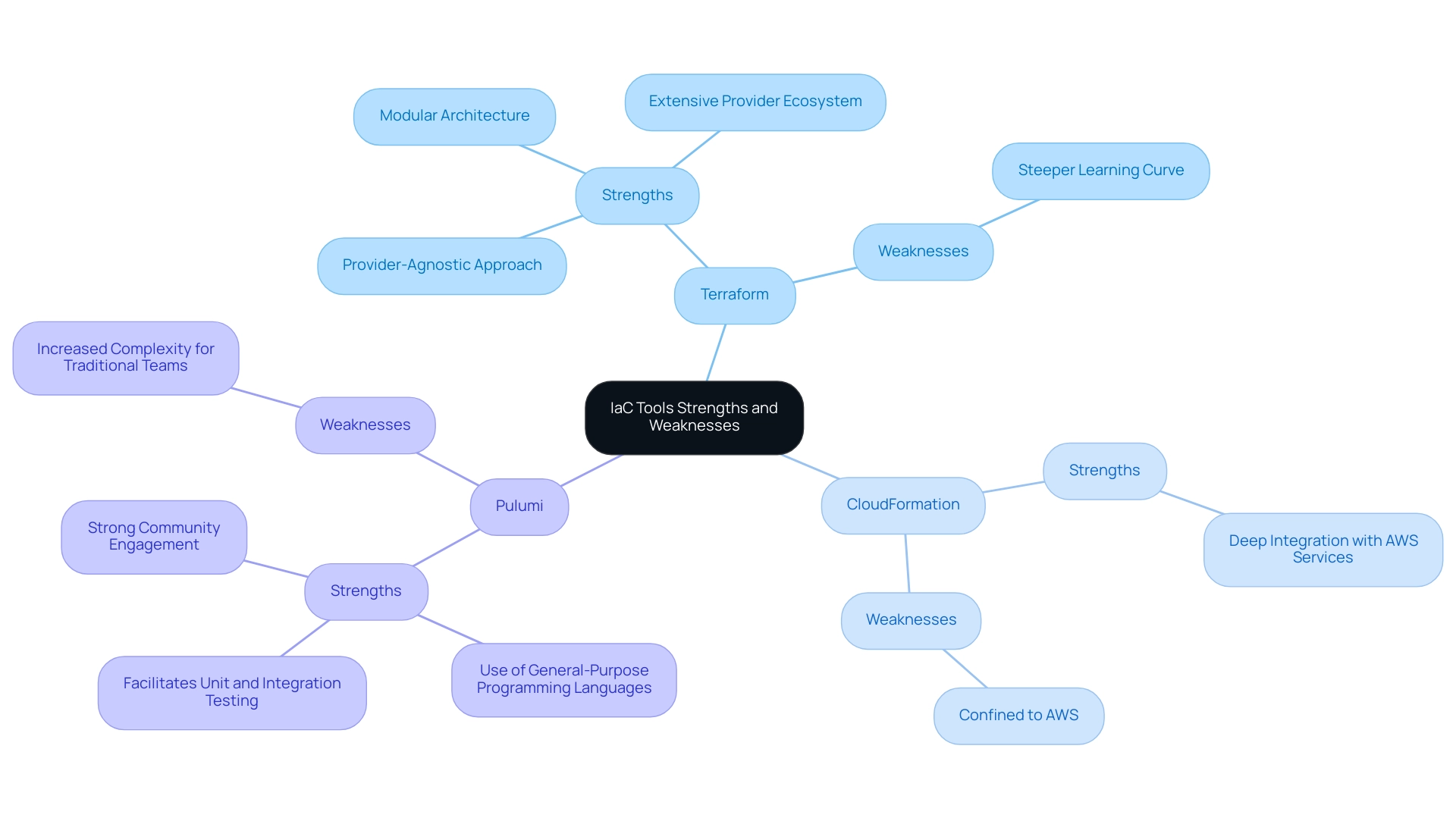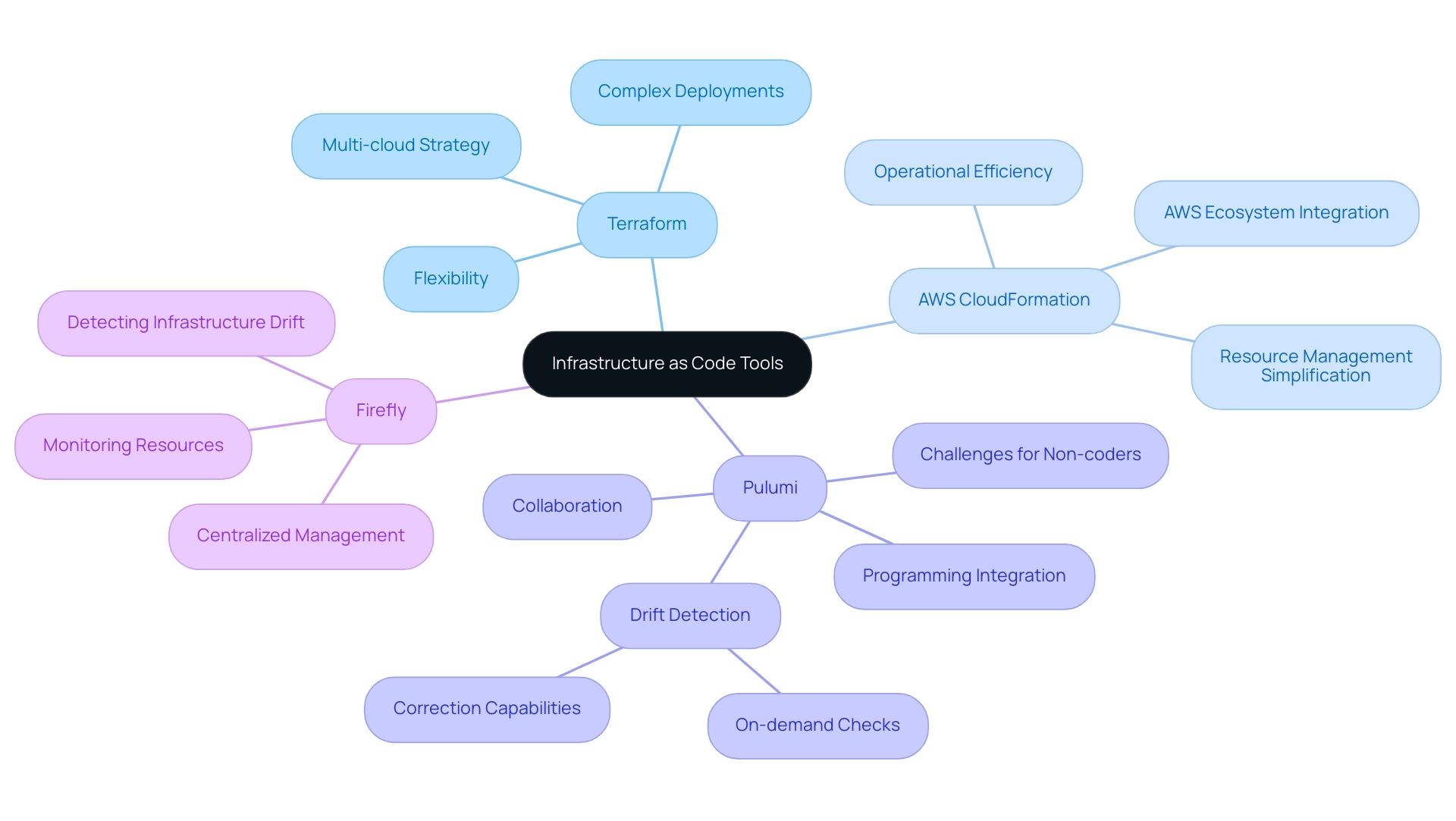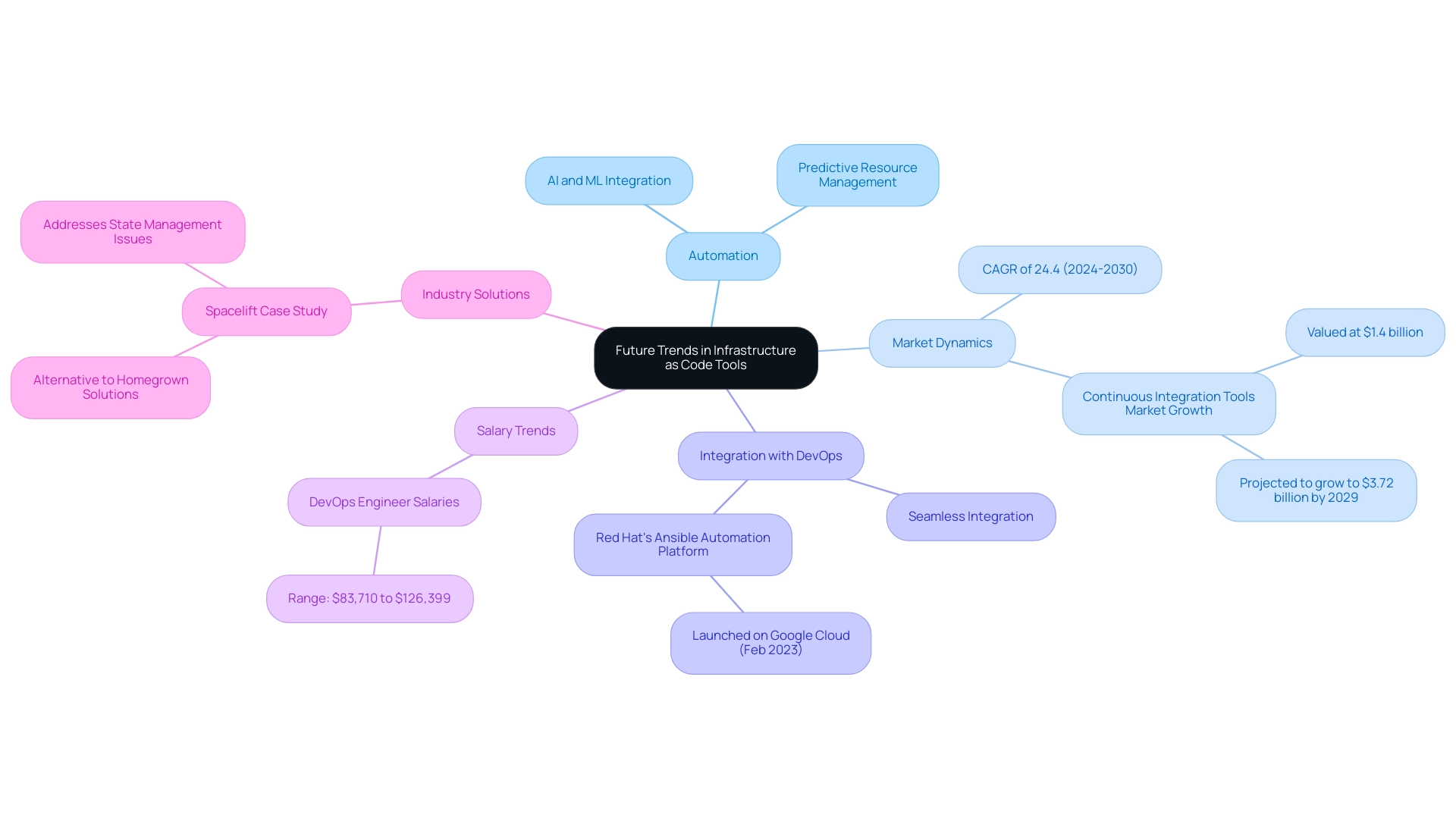Introduction
The evolution of Infrastructure as Code (IaC) marks a transformative shift in how organizations manage their IT infrastructure, moving away from traditional methods towards automated, code-driven solutions. This paradigm enables teams to provision and manage resources with unprecedented speed and reliability, fostering collaboration within development and operations—a core principle of the DevOps philosophy.
As the demand for cloud computing surges, particularly in regions like Asia-Pacific, understanding the nuances of IaC tools becomes essential for organizations aiming to optimize their infrastructure management.
This article delves into the landscape of IaC, comparing key tools such as:
- Terraform
- CloudFormation
- Pulumi
while exploring their strengths, weaknesses, and practical use cases. Furthermore, it examines future trends shaping the IaC market, highlighting the critical role these tools play in addressing the complexities of modern IT environments.
Understanding Infrastructure as Code (IaC)
Infrastructure as Code (IAC) signifies a crucial transformation in the management of IT resources, especially when using an AWS IAC tool, which utilizes machine-readable definition files instead of conventional physical hardware setups or interactive tools. This method aids in automated provisioning and management, which allows entities to deploy applications more swiftly and reliably. By treating systems in the same manner as application code, teams gain the ability to version control, test, and implement changes with remarkable ease.
This transformative paradigm not only significantly enhances operational efficiency but also cultivates collaboration between development and operations teams—often encapsulated in the DevOps philosophy, which can be improved through the use of an AWS IAC tool. As the market for AWS IAC tools continues to evolve, particularly with the anticipated growth in the Asia-Pacific region, the benefits of this methodology become increasingly clear for organizations striving to optimize their IT systems. Notably, the U.S. and Western Europe account for 82% of the world’s cloud computing, highlighting the relevance of IAC in these key markets.
Furthermore, the digitization of life and the connectivity of smart devices have led to an exponential increase in data generation, with projections indicating that by 2025, 50% of data will be stored in the cloud, up from 25% in 2015. This underscores the growing reliance on cloud solutions and the critical role of the AWS IAC tool in effectively managing this data. As articulated by ORACLE,
'MarkWide Research is a trusted partner that provides us with the market insights we need to make informed decisions.
Their reports are thorough, accurate, and delivered on time. We appreciate their professionalism and expertise, and would highly recommend their services to other companies looking for reliable market research.'
Such insights are invaluable for CTOs as they navigate the complexities of modern IT systems management.

Comparing Key IaC Tools: Terraform, CloudFormation, and Pulumi
Terraform, a product of HashiCorp, is an open-source application designed for defining and provisioning data center infrastructure through a high-level configuration language. Its ability to support multiple cloud providers makes it an exceptionally versatile solution for organizations adopting multi-cloud strategies. In contrast, AWS CloudFormation is a native service exclusively for AWS that enables users to define AWS resources using JSON or YAML templates.
This tool offers seamless integration with AWS services, making it particularly advantageous for enterprises deeply embedded in the AWS ecosystem. Meanwhile, Pulumi sets itself apart by allowing definitions of resources in popular programming languages such as JavaScript, Python, and Go. This feature resonates with developers aiming to leverage their existing programming skills, thereby simplifying the management process.
Each of these resources presents unique strengths, catering to diverse user preferences and specific organizational requirements. As the market for Infrastructure as Code (IAC) solutions, such as the aws iac tool, keeps growing, demonstrated by a compound annual growth rate (CAGR) of 23.2% anticipated from 2024 to 2033, entities must thoroughly assess their system requirements to choose the most appropriate resource. The recent enhancements in HashiCorp Terraform, particularly the new drift detection capabilities introduced in June 2022, illustrate its evolution and the benefits it brings to organizations by reducing risks and downtime while improving agility and visibility in operational processes.
As one of the largest companies in the defense industry stated, 'Thank you for sending the market report and data. It looks quite comprehensive and the data is exactly what I was looking for. I appreciate the timeliness and responsiveness of you and your team.'
This highlights the importance of having timely and relevant data when selecting an AWS IAC tool.

Strengths and Weaknesses of Each IaC Tool
Terraform's primary strength stems from its provider-agnostic approach, which enables users to manage resources across a diverse range of cloud platforms via a unified configuration file. This flexibility is further enhanced by Terraform's modular architecture, which supports the use of reusable components, thereby improving maintainability and scalability. Notably, Terraform boasts an extensive provider ecosystem, supporting thousands of providers, including major cloud providers and third-party services.
This vast network streamlines resource management and enhances Terraform's capabilities. However, it is worth noting that Terraform can present a steeper learning curve for newcomers compared to CloudFormation, particularly for those unfamiliar with the AWS IaC tool practices. On the other hand, CloudFormation excels due to its deep integration with AWS services, allowing users to effectively leverage a multitude of native features. This specialization, however, results in a significant limitation; being confined to AWS can be a drawback for organizations pursuing multi-cloud strategies, as it restricts their ability to manage resources across different environments efficiently.
Pulumi introduces a unique advantage through its use of general-purpose programming languages, which allow for the implementation of complex logic and dynamic resource creation.
With over 150,000 users and 2,000 customers, Pulumi's market presence is significant, and its GitHub repository has garnered more than 18.8k stars, indicating strong community engagement. This capability enables developers to write system code that is not only functional but also comprehensible and testable, facilitating unit and integration testing. However, this very flexibility may increase complexity and pose a steeper learning curve for traditional teams, who may be more accustomed to declarative approaches.
The difference between these AWS IaC tools highlights the diverse requirements and choices of entities as they navigate their management strategies.

Use Cases for Terraform, CloudFormation, and Pulumi
Terraform stands out as a premier choice for groups pursuing a multi-cloud strategy or those needing a consistent workflow across diverse environments. Its inherent flexibility enables the management of complex deployments efficiently, making it ideal for entities that require adaptability in their solutions. In contrast, AWS CloudFormation is tailored for enterprises fully invested in the AWS ecosystem, providing seamless integration with AWS services and significantly simplifying resource management.
This integration not only streamlines workflows but also enhances operational efficiency. Meanwhile, Pulumi is especially beneficial for development teams aiming to integrate management of resources within their current programming workflows, promoting improved collaboration among team members and speeding up iterations, aligning with the agile methodologies many organizations pursue. As emphasized in case studies, Pulumi's drift detection incorporated into its CLI demonstrates how it improves consistency of systems, providing on-demand checks and corrections.
However, some of the reasons why you might hesitate to select Pulumi for your system are that it can be difficult to get started if you come from a non-coding background. Furthermore, recent statistics indicate that 2024 has seen a significant rise in the adoption rates of IAC solutions, with the AWS IAC tool, Terraform, CloudFormation, and Pulumi being at the forefront of multi-cloud strategies. Additionally, the introduction of Firefly as a centralized platform for managing multiple IAC applications like Terraform, CloudFormation, and Pulumi provides a timely solution for organizations looking to monitor resources and detect infrastructure drift more effectively.
Each instrument serves distinct use cases, and comprehending these scenarios is vital for making informed, strategic decisions in today's rapidly evolving multi-cloud landscape.

Future Trends in Infrastructure as Code Tools
The landscape of Infrastructure as Code (IAC) tools, particularly the AWS IAC tool, is undergoing a significant transformation, driven by advancements in automation, security, and seamless integration with DevOps practices. As organizations navigate the complexities of digital transformation, future trends are expected to emphasize enhanced support for hybrid and multi-cloud environments. This shift is critical as companies increasingly demand flexibility and resilience in their infrastructure.
The average annual salaries for DevOps engineers, ranging from $83,710 to $126,399, underscore the growing demand for skilled professionals in this evolving landscape. Furthermore, the integration of artificial intelligence and machine learning into the AWS IAC tool solutions is poised to revolutionize automation capabilities, enabling predictive resource management and optimization that can significantly reduce operational overhead. The continuous integration solutions market, valued at $1.4 billion and projected to grow to $3.72 billion by 2029, reflects the broader market dynamics that influence IAC solutions.
According to recent projections, the code-based market anticipates a robust CAGR of 24.4% from 2024 to 2030, reflecting the growing appetite for sophisticated, user-friendly solutions. Real-world examples, such as Spacelift, demonstrate how alternative CI/CD automation solutions can effectively address common state management challenges, thereby enhancing overall infrastructure management. As articulated by industry leaders, including Red Hat, Inc., which launched the Ansible Automation Platform on Google Cloud in February 2023, the ongoing trend towards automation in IAC solutions, particularly through the AWS IAC tool, represents not just a technological evolution but a strategic necessity for organizations aiming to remain competitive in a rapidly changing market.
The future of the AWS IAC tool will undoubtedly be shaped by these advancements, influencing broader technology strategies and operational efficiencies.

Conclusion
The exploration of Infrastructure as Code (IaC) tools reveals their critical role in modern IT infrastructure management. By leveraging automation and code-driven solutions, organizations can enhance operational efficiency, streamline resource provisioning, and foster collaboration between development and operations teams. The comparative analysis of Terraform, CloudFormation, and Pulumi highlights the unique strengths and weaknesses of each tool, illustrating how they cater to diverse organizational needs. Terraform’s versatility, CloudFormation’s AWS integration, and Pulumi’s programming language flexibility each offer distinct advantages that can be leveraged depending on specific use cases.
As the demand for cloud computing continues to rise, particularly in regions like Asia-Pacific, the importance of selecting the right IaC tool becomes increasingly paramount. Organizations must navigate their infrastructure strategies carefully, weighing factors such as multi-cloud capabilities, team expertise, and existing workflows. The projected growth in the IaC market underscores the urgency for businesses to adapt to these technological advancements, ensuring that they remain competitive in a rapidly evolving landscape.
Looking ahead, the future of IaC tools is poised for significant transformation, driven by advancements in automation, security, and integration with DevOps practices. With the integration of artificial intelligence and machine learning, organizations can expect improved resource management and operational efficiency. As these tools evolve, they will not only facilitate the management of complex infrastructures but also empower teams to innovate and respond swiftly to changing business demands. Embracing these trends will be essential for organizations aiming to optimize their IT infrastructure and harness the full potential of cloud computing.




